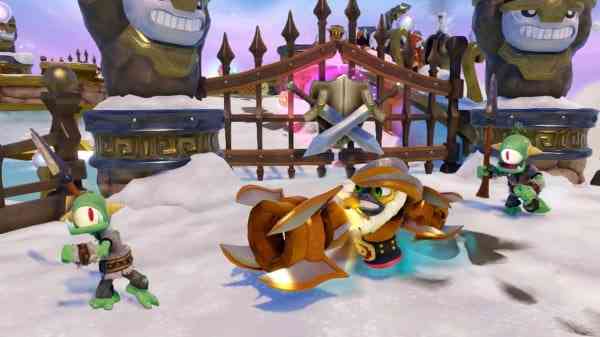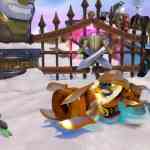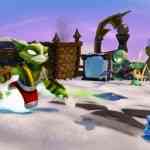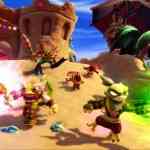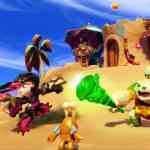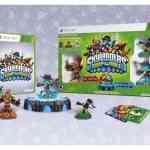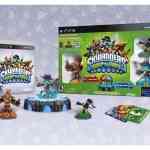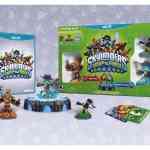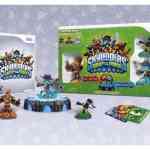Last week Activision was kind enough to fly us down to Albany, New York to visit developer Vicarious Visions for one final preview of Skylanders SWAP Force. Given the time we’ve spent with the game to date, and the fact that we have previewed it a few times, we wanted to present something different for you Skylanders fans out there rather then just write another preview article. During our time at the developer studio we got to sit down with various disciplines of the development team, and we thought it would be interesting for us to speak about what we learned in regards to the development of Skylanders SWAP Force. With this in mind, we are pleased to present to you a two-part article on various aspects of what it takes for Vicarious Visions to bring the game world of Skylanders SWAP Force alive. So, without further ado, enjoy part one.

As I sat through the various sessions we had with a wide array of people associated with the development team, one area I thought I should cover right off the hop was the process of how the idea of swappable characters came to be and what it took to actually develop figurines that allowed for mixing and matching at any given time. I was quite surprised to find out the details I did about this aspect of the development phase.
When the team first sat down and started to think about SWAP Force before it was SWAP Force, all they knew at the time was that it was going to be the third game in the Skylanders franchise. They started to think about it even before Spyro’s Adventure had hit store shelves. They wanted to do something innovative and disruptive, while still keeping the magic of bringing toys to life in a game. The team brainstormed hundreds of ideas, but what they kept coming back to was “mixing and matching” parts to create something new and something that players could consider to be their own character.
When executives from Activision came for a visit to Vicarious Visions to see what they were up to, they heard the team start to talk about mixing and matching pieces and they showed them a video about what they had in mind. Eric Hirshberg, CEO of Activision, took a look at this concept and “latched onto the idea” as he noted it was not something that he had seen before. It was Vicarious Visions first “ah-ha” moment as they saw someone who had not been through the brainstorming process and who “saw it fresh and immediately got it”. The team knew then what they were going to go forward with this idea.
The dev-team’s initial problem was figuring out how to take a figurine and make it so that players could mix and match pieces. Engineers took off the shelf electronic pieces and started coming up with ideas. One of the first engineer-designed prototypes to see if the technology could be feasible used an audio jack connector. It was not “magical” to use by any means but it was just the start of figuring out how to make these new figurines. Finding the technology was key for the team.

Concepts were all theory, as they could not find a way to bring the hardware (e.g. figurines) and software together in a manner that the game would present their overall dream. One day during the process one of the dev-team took a bunch of Skylander figurines home, and at about midnight that night he e-mailed a video that became the catalyst for coming up with an idea for the figurines. Simply put, the 10-second video showed that by using magnets you could put different pieces of characters together. They had been experimenting with other methods, such as lock and key, but the 10-second video showed one of the dev-team members clicking together three pieces of a Skylander together with one hand. This was a key point as it was simple to do, so a child could do it without any problem.
When all the team was in the studio the next day they were all excited. That being said, one of the main concerns for was that the magnets would interfere with the memory in the base and cause problems with putting the figurines on the portal and putting the character into the game. Well low and behold they put the magnetized figurine on the portal and “boom”, the character showed up on screen.
The team had to then show their now fully recognized concept to Activision again. They had to figure out how to “divide” the character to allow for swappable parts. The main question then became “how were they to divide the character up?” They thought about cutting him down the middle, at the waist, do they socket the arms and the back, do they take the tail off…they were so many ways to do things. As they weighed the pros and cons it was clear that simplification was going to yield the best results. As they went into ‘kid testing’ they discovered that the simpler the design, the easier it was for kids to get it.
Initially they had a three-part design but they discovered that kids thought they were breaking the figurines, as the magnet strength was not strong and it made the figurine feel weak. They then tried a two-magnet approach, as it felt stronger and more robust. This led to the simplest of messages which became the anchor of the SWAP Force design: “Choose how you fight, choose how you move”. The top half dictates how your character fights and the bottom half dictates how you move. You can put characters together in no time and get into the game quickly. Alas the SWAP Force design was born.
After sitting down and learning what the actual process was like to come to the resolution of doing a game with swappable characters, and then what it took to figure out how to make figurines that would satisfy all game development areas, I didn’t know what else I could learn about. Oh boy, was I silly to think that.
I got a further understanding of how in-game characters are created as well as some information about developing combat for the gameplay. In regards character development, the team described some of the design aspects for one of the new characters Fryno, a new fire character. One of the challenges with Fryno was to create something new, as they have characters that already shoot fire. With this in mind they started to explore the idea of heated metal. Each character that is designed goes through a conceptual process, and as Fryno went through this stage it was clear he would be designed with idea of forging things and heating up metal.
So with their new thoughts and ideas, the concept of Fryno with a little blowtorch and a pair of pliers was created. It had elements of where they wanted to go, but he was carrying tools and not weapons, he looked like he was a character that had a 9-5 job; he didn’t look heroic. So alas they talked to Toys for Bob and others and figure out if he is a good Skylanders character. Fryno had to fit within the existing world of Skylanders so more work had to be done. As time went by Fryno continued to evolve. One of his attributes is his ability to ride a motorcycle. His original motorcycle only had one wheel, but once they got the motorcycle in the game, along with a close to final version of Fryno, they had to make changes as he again just didn’t look right. They ended up putting him on a two-wheeled motorcycle as the one-wheeled motorcycle looked too top heavy and seemed like it would tip over at any time.
Character designers have ideas for moves, but not all moves can be created the way they want. Combat moves have to be fine-tuned throughout to meet not only the expectations of the creators, but what can be done in the game too. These ideas have to meld into one so to speak and everything has to come together. For example, one of Fryno’s moves consisted of his hands shooting out, grabbing an enemy, and pulling them toward him. Unfortunately, during Fryno’s development this didn’t seem to suit the game, as it seemed out of place for the look of not only Fryno, but also the game itself. He is better as a close combat character, and the hands shooting out broke away from the feel of Fryno. The team discovered that it wasn’t fun and didn’t meet the technical specification of the game. This move just pulled away from the core character and therefore it was scrapped.
Another key move/feature that went through a lot of change is the aforementioned motorcycle that Fryno is paired with. This was originally slated to be down in one section of his skill tree; however, during the play testing kids were like “why wouldn’t you choose the motorcycle?” So with this revelation in mind, Fryno’s initial motorcycle move was moved up into the main stream of the whole skill tree earlier on so all players, no matter what path they choose (e.g. brawler vs. motorcycle path), will have access to the basic move. Kids loved it and it made sense.
One of the things I was personally interested in, given my 7 year old son’s past experiences with the game, had to do with balancing the characters when kids take them into Arena Battle. The combat designers actually take many different things into account for this mode. They recognize there are a lot of characters that have some really insane abilities and it’s not just a matter of how long it takes to pull off moves and the resulting damage. The combat designers did a lot of testing with kids to see how easy moves are to pull off and how often they would do them. The moves that were used more often are assigned less damage and the trickier moves are rewarded with more damage, as they are not used all the time. The speed of moves is also taken into consideration, from how quick the more powerful moves “recharge” to how quick the actual character is. They have closed some of the game’s character speed differences, to make them a little closer but not identical.
Something that became evident to me during this section of our day is the amount of kid testing that the dev-team. Many aspects of the game development are spent working with kids from outside the studio and seeing how they react to various aspects of the game. The area of combat is one such area, as they watch kids as they play to see what they do, how fun they are having doing it, and how they react to various aspects of the combat mechanics. It was amazing to hear that they really took the kids input to heart, instead of trying to have kids adapt to what they want them to play. Given the audience of the Skylanders universe, they make sure that the kids who are testing the game are indeed having fun. Sure, this sounds just like a business decision, but it is more than that, as they truly want kids to have fun with this game, combat and all.
We are going to stop here for now. The second part of this article will be forth coming in a few days or so. I will cover some technical areas such as sound, rendering, and cinematics. All in all I think that this article, as well as the second one that I have yet to finish, will show you how much hard work has gone into Skylanders SWAP Force. I know that after my time at Vicarious Visions I have even more appreciation for what they have done to bring this game ‘alive’.
